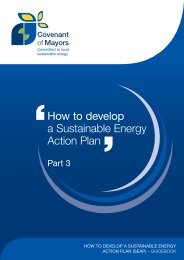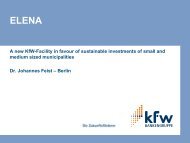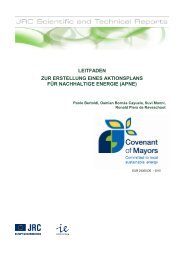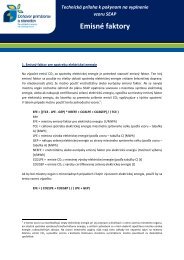English - Covenant of Mayors
English - Covenant of Mayors
English - Covenant of Mayors
You also want an ePaper? Increase the reach of your titles
YUMPU automatically turns print PDFs into web optimized ePapers that Google loves.
Box 1 gives additional information on how to deal with<br />
biomass or bi<strong>of</strong>uels ( 4 ) which are used in the territory <strong>of</strong><br />
the local authority.<br />
In the case <strong>of</strong> a bi<strong>of</strong>uel blend, the CO 2<br />
emission factor<br />
should reflect the non-renewable carbon content <strong>of</strong> the<br />
fuel. An example <strong>of</strong> calculation <strong>of</strong> an emission factor for<br />
a bi<strong>of</strong>uel blend is presented in Box 2.<br />
BOX 1. SUSTAINABILITY OF BIOFUELS/BIOMASS<br />
Sustainability <strong>of</strong> bi<strong>of</strong>uels and biomass is an important<br />
consideration in the preparation <strong>of</strong> the Sustainable<br />
Energy Action Plan. In general, biomass/bi<strong>of</strong>uels are<br />
a form <strong>of</strong> renewable energy, the use <strong>of</strong> which does<br />
not have an impact on the CO 2<br />
concentration in the<br />
atmosphere. However, this is the case only if biomass/<br />
bi<strong>of</strong>uels are produced in a sustainable manner. Two<br />
sustainability issues should be taken into consideration<br />
when deciding on SEAP measures related to biomass/<br />
bi<strong>of</strong>uels, and when accounting for them in BEI/MEI.<br />
1. Sustainability in relation to CO 2<br />
concentration<br />
in the atmosphere<br />
Combustion <strong>of</strong> carbon which is <strong>of</strong> biogenic origin, for<br />
example in wood, biowaste or transportation bio fuels,<br />
forms CO 2<br />
. However, these emissions are not ac counted<br />
for in the CO 2<br />
emission inventories, if it can be<br />
assumed that the carbon released during combustion<br />
equals the carbon uptake <strong>of</strong> the biomass during<br />
re-growth within a year. In this case, the standard CO 2<br />
emission factor for biomass/bi<strong>of</strong>uel is equal to zero.<br />
This assumption is <strong>of</strong>ten valid in the case <strong>of</strong> crops<br />
which are used for biodiesel and bioethanol, and is<br />
valid in the case <strong>of</strong> wood if the forests are managed<br />
in a sustainable manner, meaning that on average<br />
forest growth is equal to or higher than harvesting. If<br />
wood is not harvested in a sustainable manner, then<br />
a CO 2<br />
emission factor that is higher than zero has to<br />
be applied (see Table 4).<br />
Therefore, the local authority is recommended to<br />
check that the biomass/bi<strong>of</strong>uels used meet certain<br />
sustainability criteria. The criteria ( a ) set in directive<br />
2009/28/EC on the promotion <strong>of</strong> the use <strong>of</strong> energy<br />
from renewable sources may be used for this<br />
purpose. After 5 December 2010 (date by which<br />
Member States shall bring into force the laws,<br />
regulations and administrative provisions necessary<br />
to comply with this Directive), only biomass/bi<strong>of</strong>uels<br />
that meet these criteria should be considered as<br />
renewable in the context <strong>of</strong> the <strong>Covenant</strong> <strong>of</strong> <strong>Mayors</strong>.<br />
In the case the local authority uses standard<br />
emission factors and uses bi<strong>of</strong>uel which does not<br />
meet sustainability criteria, it is recommended to use<br />
an emission factor that is equal to that <strong>of</strong> the<br />
corresponding fossil fuel. For example, if the local<br />
authority uses biodiesel which is not produced in<br />
a sustainable manner, the emission factor <strong>of</strong> fossil<br />
diesel is to be used. Even though this rule does not<br />
follow the conventional emission estimation<br />
standards, it is applied to prevent the use <strong>of</strong> unsustainable<br />
bi<strong>of</strong>uels in <strong>Covenant</strong> cities. If the local<br />
authority uses LCA emission factors, and uses<br />
bi<strong>of</strong>uel which does not meet sustainability criteria, it<br />
is recommended to develop an emission factor,<br />
which takes into account all the emissions over the<br />
entire life cycle <strong>of</strong> the bi<strong>of</strong>uel.<br />
The emission factors for the fuels which are most<br />
commonly used in the territories <strong>of</strong> the local authorities are<br />
presented in the Table 4, based on 2006 IPCC Guidelines<br />
and European Reference Life Cycle Database (ELCD) ( 5 ).<br />
Annex I gives a more complete table <strong>of</strong> IPCC emission<br />
factors. However, the local authority can decide to use<br />
other emission factors which are considered appropriate.<br />
11<br />
2. Life cycle emissions, biodiversity and other<br />
sustainability issues<br />
Even though bi<strong>of</strong>uel/biomass would represent<br />
a neutral CO 2<br />
balance, its usage may not be considered<br />
as sustainable if its production causes high<br />
emissions <strong>of</strong> other greenhouse gases – such as N 2<br />
O<br />
from fertilizer use or CO 2<br />
due to land use change –<br />
or has an adverse impact on biodiversity, for example.<br />
(4) In these guidelines, bi<strong>of</strong>uel refers to all liquid bi<strong>of</strong>uels, including transportation bi<strong>of</strong>uels, vegetable oils and other fuels in liquid phase.<br />
Biomass, instead, refers to solid biomass such as wood, biowaste, etc.<br />
( a ) See article 17 <strong>of</strong> the directive, paragraphs 1 to 6. In very short: ‘The greenhouse gas emission saving from the use <strong>of</strong> bi<strong>of</strong>uels and bioliquids,<br />
[calculated in accordance with Article 19] […] shall be at least 35 % […] Bi<strong>of</strong>uels and bioliquids […] shall not be made from raw material<br />
obtained from land with high biodiversity value […] from land with high carbon stock […] from land that was peatland in January 2008 […]’. In<br />
addition, ‘Agricultural raw materials cultivated in the Community and used for the production <strong>of</strong> bi<strong>of</strong>uels and bioliquids […] shall be obtained in<br />
accordance with the requirements and standards […]’ <strong>of</strong> various environmental provisions <strong>of</strong> European agricultural regulations.<br />
(5) The emission factors for fuel combustion are expressed as t/MWh fuel<br />
. Therefore, the corresponding activity data to be used must also be<br />
expressed as MWh fuel<br />
, which corresponds with the Net Calorific Value (NCV) <strong>of</strong> the fuel.












